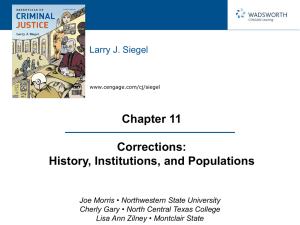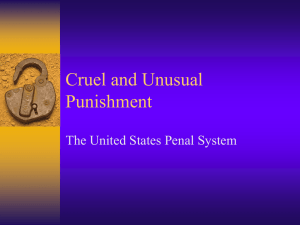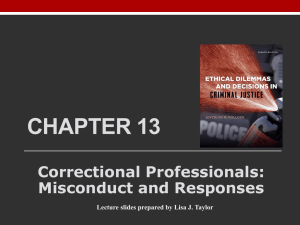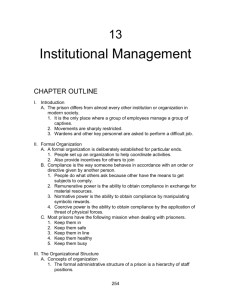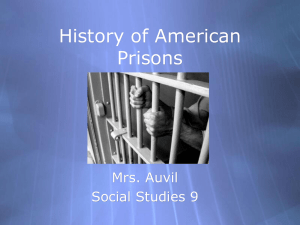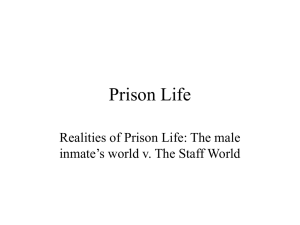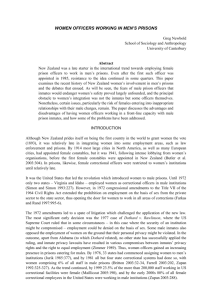Chapters 12-13 PowerPoint
advertisement
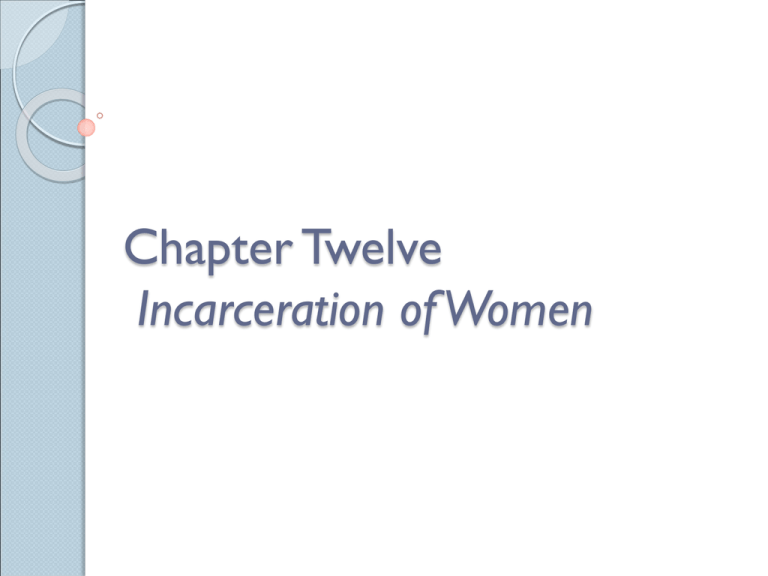
Chapter Twelve Incarceration of Women Learning Objectives Explain why women prisoners are called the “forgotten offenders.” 2. Be familiar with the history of the incarceration of women. 3. Explain how interpersonal relationships in women’s prisons differ from those in men’s prisons. 4. Be familiar with the special issues that incarcerated women face. 5. Discuss the problems women face when they are released to the community. 1. Learning Objective 1 Learning objective 1: Explain why women prisoners are called the “forgotten offenders.” Forgotten Offenders • Institutionalized sexism: – Women’s prisons generally located farther from friends and families – Small number of women in prison and jail is used to “justify” lack of diverse educational, vocational, and other programs available to incarcerated women. – Small number used to “justify” low levels of specialization in treatment and failure to segregate the more-serious and mentally ill offenders from the less-serious offenders. Forgotten Offenders • • • Women make up 6.8% of federal and state prison population More than 114,000 females incarcerated Women account for 24.2% of all arrests for serious crimes: – 68% for arrests for prostitution and commercialized vice – 44.1% arrested for fraud – 38% arrested for forgery Learning Objective 2 Learning objective 2: Be familiar with the history of the incarceration of women. History • • Early 1800s, separate facilities from men proposed Late 1800s reform: – Separation of women prisoners from men – Provision of differential care – Management of women’s prison by female staff • • • Reform movement ran its course by 1935 No distinctive model since 1940s 1970s-1980s, women issue deferred by concern over rising male prison population Learning Objective 3 Learning objective 3: Explain how interpersonal relationships in women’s prisons differ from those in men’s prisons. Relationships Sexual relationships more voluntary than in men’s prisons • Female inmates tend to form pseudofamilies: • – Father – Mother – Daughter – Sister Prisons less violent, less gang activity, and do not have same racial tension. • Women’s interpersonal relationships were less stable and less familial in the past. • Higher levels of mistrust and greater economic manipulation. • Relationships Informal social structure of female prison is collectivist. Characterized by warmth and mutual aid extended to family and kinship members: ◦ Male prisoners adapt by self-sufficiency, a convict code, and solidarity with other inmates. Learning Objective 4 Learning objective 4: Be familiar with the special issues that incarcerated women face. Special Issues Sexual misconduct: ◦ Any behavior that is sexual in nature that is directed toward an inmate by an employee, official visitor, or agency representative. ◦ Include: Touching genitalia, breast, or buttocks in a way that is intended to arouse, abuse, or gratify sexual desire Using threats or making requests for sexual acts Indecent exposure and staff voyeurism for sexual gratification Special Issues • Educational and Vocational programs: – Glover v. Johnson – Most female offenders undereducated and unskilled – Women not being prepared for jobs • Medical services: – Women usually have more serious health problems – Gynecological problems Special Issues ◦ Higher percentage of female than male state prison inmates reported a medical problem since admission such as: Arthritis Asthma Cancer Heart problems Liver problems Hepatitis Sexually transmitted disease Special Issues • Mothers and their children: – Over 60% of female inmates in state prisons are mothers of minor children. – Nearly 58% do not see their children during their sentence. – Birth in prison – 90% of states offer parenting classes – 75% provide special visiting areas – 28% overnight visits – 7% nurseries Learning Objective 5 Learning objective 5: Discuss the problems women face when they are released to the community. Problems Upon Release Most are poor Have lost custody of their children Have serious health care needs Have extensive substance abuse histories 60 to 70% have nowhere to go and have to find a place to live Chapter Thirteen Institutional Management Learning Objectives 1. 2. 3. 4. Be familiar with the principles used to organize the functioning of prisons. Discuss the importance of prison governance. Discuss the different job assignments that correctional officers are given. Understand the negative consequences of boundary violations and job stress among prison staff. Learning Objective 1 Learning objective 1: Be familiar with the principles used to organize the functioning of prisons. Concepts of Organization • Unity of command: – Subordinate should report to only one supervisor • Chain of command: – A series of organizational positions in order of authority, with each person receiving orders from the one immediately above and issuing orders to the one(s) immediately below. • Span of control: – A supervisor can effectively oversee only a limited number of subordinates. Concepts of Organization • Line personnel: – Employees who are directly concerned with furthering the institution’s goals and who are in direct contact with clients. • • • • Custody force Industry and agricultural supervisors Counselors Medical technicians – Majority of personnel – Organized along military lines Concepts of Organization Staff personnel: ◦ Employees who provide services in support of line personnel; examples of staff personnel including training officers and accountants. Usually work under the deputy warden for management Concepts of Organization Warden ◦ Chief executive of institution ◦ Institution’s main contact with the outside world Concepts of Organization Learning Objective 2 Learning objective 2: Discuss the importance of prison governance. Governing Prisons Inmate balance theory: ◦ For a prison system to operate effectively, officials must tolerate minor infractions, relax security measures, and allow inmate leaders to keep order. Administrative control theory: ◦ Prison disorder results from unstable, divided, or otherwise weak management. Governing Prisons Effects of administrative breakdown: ◦ Inmates believe their conditions of confinement are not only bad, but unjust. ◦ Officials become indifferent to routine security measures and day-to-day tasks of prison management. ◦ Permits gangs and other illicit groups to flourish, may help mobilize disturbances. Governing Prisons Most important factor in governing prisons: ◦ Sound and firm management of inmates and staff. Order Absence of individual or group misconduct threatening the safety of others. Amenity Anything that enhances the inmates’ creature comforts. Service Programs designed to improve the life prospects of inmates. Governing Prisons Four factors that make governing prisons different from administering other public institutions: ◦ ◦ ◦ ◦ Defects of total power Limited rewards and punishment Co-optation of correctional officers Strength of inmate leadership Governing Prisons Accommodative relationships between officers and inmates: ◦ Negotiations are central to prisoner control, correctional officers cannot have total control over inmates. ◦ Once an officer defines a set of informal rules with prisoners, the rules must be respected by all parties. ◦ Some rule violations are “normal” and consequently do not merit officers’ attention or sanctioning. Governing Prisons Management is successful when prison directors: ◦ Are in office long enough to learn the job, make plans, and implement them. ◦ Project an appealing image to a wide range of people, both inside and outside of the organization. ◦ Are dedicated and loyal to the department, seeing themselves as engaged in a noble and challenging profession. ◦ Are highly hands-on and proactive. Learning Objective 3 Learning objective 3: Discuss the different job assignments that correctional officers are given Correctional Officers Block officer: ◦ ◦ ◦ ◦ Closest contact with prisoners Oversee unit maintenance Watch for potential breaches of security Handle inmates’ personal problems and answer questions ◦ Enforce rules ◦ Inmate safety ◦ Carry out orders of warden Correctional Officers Work detail supervisors: ◦ Supervise various work details connected with inmate labor. ◦ Inmate-officer relationship can be analogous to worker and foreman in a factory. Industrial shop and school officers ◦ Maintenance and security responsibilities ◦ Work alongside civilians, shop supervisors, teachers, and counselors. ◦ Keep attendance Correctional Officers Yard officers: ◦ Yard most unstructured environment in the prison ◦ Supervising inmates Administration building assignments: ◦ Very little contact with inmates ◦ Interact with administrators, commissioner’s office, and civilians Correctional Officers Wall posts: ◦ ◦ ◦ ◦ Towers Generally no contact with inmates Solitary and boring Typically new recruits Relief officers: ◦ Variety of tasks, fill in vacancies of other positions Learning Objective 4 Learning objective 4: Understand the negative consequences of boundary violations and job stress among prison staff. Boundary Violations Behavior than blurs, minimizes, or disrupts the social distance between prison staff and inmates, resulting in violations of departmental policy. ◦ One study found: 80% of violations involved dual-relationships, consensual 8 %, general boundary violations 12% staff-inmate sexual contact Boundary Violations Violations contribute to: ◦ Disorder ◦ Potentially jeopardize officers’ safety ◦ Costly lawsuits Job Stress Factors: ◦ Relationships with co-workers ◦ Departmental policies ◦ Length of time on job Consequences: ◦ ◦ ◦ ◦ ◦ More sick time More problems at home Heart disease Eating disorders Substance abuse Job Stress Advantages of reducing stress and burnout: ◦ Financial savings ◦ Fewer resources expended Overtime Hiring ◦ Safety levels ◦ Staff morale

